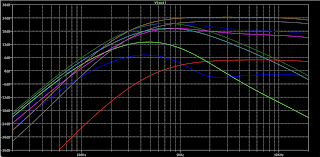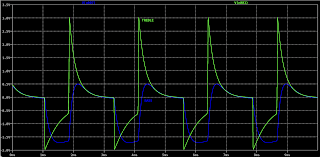I couldn't find a layout for the FS-77 anywhere, but I did find some photos online, so I decided to try and trace it back in November 2020. I thought I had it, but when I looked at it again recently, I noticed the input didn't look right. The caps were the wrong way around for an input blend... hmmm. If it's not an input blend, what is it?
So I went looking for more information, and recently someone was kind enough to share some photos with me (you're a legend), which completed the picture - I was a bit lost without the additional photos, and had mistaken the blend pot for an input blend, which is not uncommon on D*A*M designs.
THE BONES OF THE FS-77
So what is the FS-77? Like most Fuzz Sounds, it's a Tone Bender MKIII with tweaks.
- The collector resistor on Q1 & Q2 is only 4k7, as opposed to 10k
- 4.7uf input cap, with a 10n to ground
- Usual 220pf cap across collector and case of Q1 is 47pf
- Sonically the biggest change is the tone & blend controls, which are based on a Big Muff tone stack. The blend is a kind of a mid-range control, based on the same idea as the AMZ presence control. The blend pot changes the high-pass filter cut-off, which forms one half go the BMP tone stack.
D*A*M FS-77 FUZZ SOUND SCHEMATIC
ASSUMPTIONS
There are some component values that I've not seen, all other values have been seen on photos.
- Fuzz, tone and volume have been assumed based on normal tone bender values used by D*A*M
- Initially I had a 25k pot for blend, but after testing it, I've landed on 50k. Try some different values, maybe you prefer a 25k - the 50k just has a slightly wider range. Being a BMP tone control, it's easy enough to tune to your personal taste, even if the stock FS-77 values are a little unfamiliar.
- The 220n between the tone and volume might be a different value - looks the same as the 220n on the board, and is large enough to not impact the frequency response after the tone control
TONE CONTROL
Despite being a BMP based tone control, they're not even close to typical BMP values
It does allow a mid hump, as well as a bit of a scoop on some settings.
Bass, low-pass filter
220k & 2.2n = 329hz
Treble, high-pass filter
25k pot: 10n cap & 1.5k - 26.5k = 600hz to 10.6khz sweep
50k pot: 10n cap & 1.5k - 51.5k = 300hz to 10.6khz sweep
LTspice - tone & blend swept in values from 1, 50 & 100% (50K blend pot)
ON THE BENCH
It works... it gives you some classics tone bender MKIII tones, and then some more modern sounds as a result of the tone control.
The blend provides a nice sweep, and works well with the tone control. There’s a lot of useable tones in there. I prefer the 50k pot as you get more range.
I ended up using a wider piece of tag board as I'm going for a landscape layout in the enclosure.







12 comments:
Great job!
Been curious about this one ever since it was realsed but appearantly you have a sharper eyes than me.
Any plans to build the layout and test it?
Have drwan a schematic based on your layout and looks like a DAM TB# with input cap blend derived from Meathead Deluxe and Drag n Fly.
The only other pedal I've seen with a small collector resistor for the darlington pair is in Schaller Fuzz Sustain in it works great.
I'll definitely build it, hopefully over this weekend or the next, depending on home/work requirements. I may even order the proper board instead of using vero. Even though there's a few assumptions on values, it should be pretty close.
I was amazed that I found a D*A*M circuit that I couldn't find a layout for, so I couldn't leave that alone.
I have it on the breadboard - looking good, will fire it up with an amp tomorrow to see how it sounds. Tagboard and mojo resistors arriving next week.
Looking forward to hear how it turns out!
Still, there is a few more DAM's to be traced. First one that springs to mind is Super Bee 68...it is supposed to be a fat and heavy TB Mk2. What not to like?
https://stompboxes.co.uk/forum/viewtopic.php?f=44&t=20803
I had a look at the Super Bee SB-68. It's a pretty standard looking MKII, built on a very tight layout to fit the smaller enclosure. The only thing I spotted that was out of the ordinary is a 220pf cap across C/B of Q2. I also spotted a few different bias resistors paired with the 8k2 from 470, 560 and I think I saw a 1k.
Also looks like there's two versions. One with the 10n to ground on Q1, and one without. https://reverb.com/item/1502552-dam-d-a-m-super-bee-68-sb-68
Can't see the other cap values, although he did say it was basically the same as the SB-67 with the Super Bee treatment.
I tested it with an amp a few minutes ago - sounds like a MKIII... was expecting that much. The tone control is cool, but it has a very limited useful range, the top end is pretty severe. Could use either the 50k or 100k depending on taste - the 50k has more mids, the 100k has a pretty decent scoop when it's right on 50% - sounds a bit like a super fuzz (which I like). I might try a few more BMP tonestack options on the breadboard. I'm thinking Elk and stock Rams head.
The input blend is useful, but not dramatic.
Like a MKIII, it's not that fussy re transistors.
NOTE: comments above all relate to a previous version, which was incorrect.
Hi Andy, is the tagboard updated now. Really want to build this one. Many thanks!!!
Hi Ian - yes, I’ve built it.
It sounds pretty good Ian - think of a more modern MKIII sound, but still retains a fair bit of MKIII character. The balance and tone control are very useful - a lot of good tones in there.
Built it today Andy and it sounds great, definitely a lot of MKIII in there. Looks very handsome on tagboard also!!! Many thanks again
Good to hear. I’m kind of surprised D*A*M didn’t make more of them.
Post a Comment